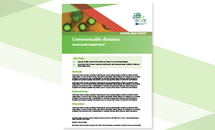Congenital syphilis - Annual Epidemiological Report for 2022
Take our survey
Share your feedback in our short survey and help us improve publications at ECDC. Your input is valuable!
In 2022, 69 confirmed congenital syphilis cases were reported from 14 EU/EEA countries, while 11 other countries reported zero cases. For 2021, 55 cases were reported by 11 countries out of 24 contributing data.
Executive Summary
- The number of cases reported in 2022 and 2021 represent an overall increase in congenital syphilis notifications in the EU/EEA that follows a decrease in notifications in 2020.
- Increases in congenital syphilis in 2022 were paralleled by increases in the notification rates of syphilis among women and heterosexual men in several of the EU/EEA countries in 2022.
- National rates remained low in most EU/EEA countries that provided data on congenital syphilis between 2013 and 2022. Five countries reported zero vertical transmission events during the 10-year period.
- This report may include some underreporting: five countries for 2022 and six for 2021 did not contribute to the reporting of congenital syphilis and one of the countries that reported has a sentinel surveillance system.
- To achieve the revised 2030 targets for congenital syphilis elimination in the WHO European Region, particularly in EU/EEA Member States that report higher number of cases, better indicator data are needed to ascertain the factors associated with congenital syphilis prevention failures. Countries that currently do not collect data may benefit from documenting their progress towards congenital syphilis elimination, particularly given the current increases in syphilis notifications among women in the EU/EEA.
Download

Congenital syphilis - Annual Epidemiological Report for 2022
- EN - [PDF-530.75 KB]






